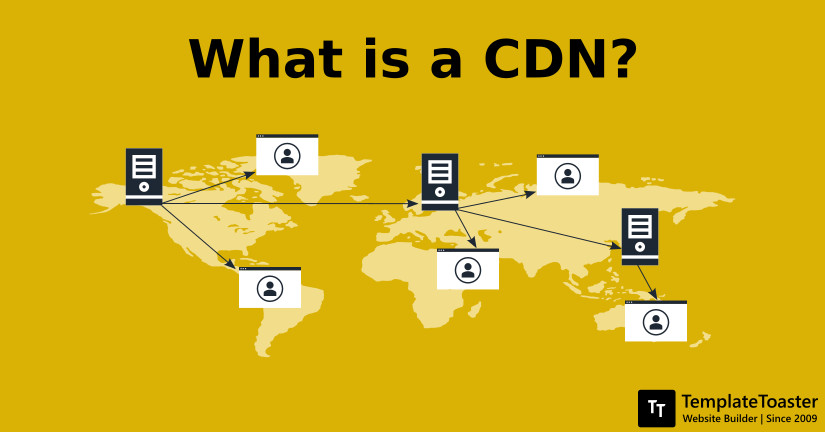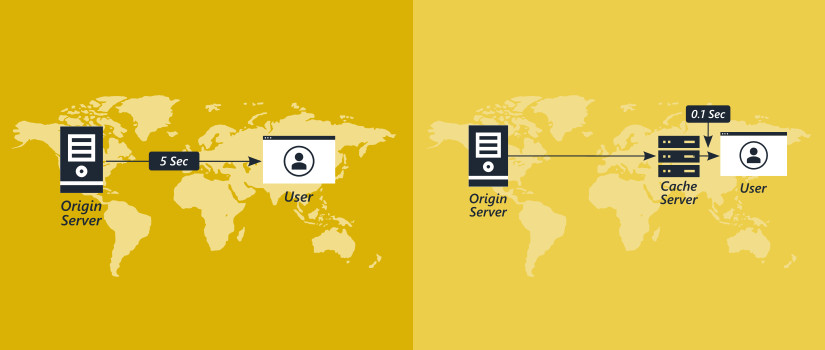CDN Tutorial for Beginners

You keep seeing an acronym- CDN. Sometimes, in URLs or on the landing pages, but it never really clicked. So, what exactly is a CDN or Content Delivery Network? What exactly they do? In this article I am going to explain the concept of CDN and why we need it.
What is a CDN? Tutorial for Beginners
A highly distributed platform of servers to minimize delays in loading content of web pages by reducing the physical distance between the server and user is the Content Delivery Network. It helps in maintaining the same high-quality content to users around the world without any delay. They are designed to resolve the issue of ‘latency’ that is unwanted delays in the loading of the content on the screen. In other words, a bunch of servers is positioned in different geographical areas between the origin server and the user’s location with the primary purpose of faster delivery of the content, simultaneously reducing latency.
Without a CDN, every single user’s request will go directly to the origin server. As a result, the origin server will have to respond to every request, resulting in significant traffic and subsequent load. Hence, chances of traffic spikes and server failure are higher, if the load is persistent. However, by positioning a CDN to respond to the user’s requests between the user’s location and origin server, traffic can be offloaded from the origin server. It reduces the latency and increases the web experience. Here at TemplateToaster, we often talk about ways to optimize a website. Let’s dig deeper.
How CDN works?
The primary goal of CDN is to reduce the latency. To understand the concept, let’s take an example. Suppose, a US visitor wishes to view content that originates at a UK-based server. It means the content has to travel all the way through the Atlantic. No wonder the request will be responded poorly because of the physical distance. Hence, to combat this, CDN is positioned. It will store a cached version of your website content in multiple geographical locations around the world, known as PoPs (Points of Presence). So your website will be served to the US visitor from a US-based POP hence decreasing the latency. They have their own caching servers, primarily responsible for delivering the content in the user’s location. Devices running web browsers, also known as user-agents, generate requests for content needed to extract web pages like HTML, CSS, images, and JavaScript files.

Each request from the user will map the end-user on an optimally-located CDN server for most CDNs. after that, the server will respond with the cached version (pre-fetched) of the requested content. However, if it fails to retrieve the requested file, it will proceed to look for the requested data on the other servers in the CDN platform and send the response to the end-user. When the content is unavailable or stale, CDN acts as a request proxy to the origin server and fetch the latest content for future requests. Although web content delivery is the primary use case of CDN, it’s not limited to that only. It can fetch and serve a wide array of content including video streaming, audio streaming, data files, software download files, OS updates, etc. As long as the data can be digitized, it can be delivered through CDN.
Why CDN is needed?
If you want to increase the speed of your website with lowered latency, CDN is your solution. They ensure faster, safer, and most efficient content delivery to users around the world. Moreover, it is not limited to website content delivery only. It can also deliver 4K and HD-quality video, download files for applications, audio files, and OS updates. Website visitor attention is growing shorter by each passing day, which makes it imperative to deliver the content as quickly as possible. The internet is responsible for globalization. More businesses are going online, and the world is coming together on the internet to connect, share, and shop. Meanwhile, it is becoming challenging for content providers to deliver different types of content on different devices, across different locations, securely. However, it possesses some inherent capabilities of a content delivery that can offer efficient solutions to the businesses to the aforementioned challenges. Here at Templatetoaster website builder you may read Sucuri vs Cloudflare, Fastly vs Cloudflare, Imperva vs Cloudflare, Stackpath vs Cloudflare, Cloudflare vs Cloudfront, Cloudflare vs Akamai.
CDNs have been serving for more than 20 years now and are acting as the unseen backbone for the internet. It is overcoming the challenges of media delivery in diverse fields including finance, healthcare, retail, and other businesses. If you’ve ever done anything online, you’ve benefited from a CDN without even knowing it. The Internet wasn’t designed to do all the wonderful things it is doing now. Therefore, to keep the experience smooth and flawless, CDN is much needed. After implementing this service, you can also check the speed of your site using Google Page Speed. Moreover, other than Google Page Speed, there are ample of other website speed test tools available.
What are the benefits of CDN?
CDN is specifically built to keep the internet amazing. Today, a massive amount of data is handled on the internet on a regular basis. Then, there are also flash sales, live video streaming, large downloads, etc are held on the internet. It is all possible because CDN is supporting it. In specific terms, some of the major benefits CDN offers to a business are:
Higher Availability
CDN offers high availability. It means the data will be accessible to the end-users even under stressful situations like intermittent spikes, excessive user traffic, or potential server outages. Under the high-stress situations, even the most powerful origin servers give up. In the absence of CDN, the origin server would have to endure all the requests, resulting in terrible web experience and potential business loss. This is the reason it adds immense value to the online infrastructure of an online business. Because the concept of multiple server locations distributes the load and offers a great web experience, which ultimately will affect your SEO ranking positively.
Bonus Read: Read how you can troubleshoot service unavailability errors when you don’t have CDN services.
Better Performance
When a user generates a request, it is crucial for businesses to deliver as quickly as possible because a mere delay of milliseconds can make your user abandon your website. CDN keeps the data cached and responds quickly to requests by eliminating the need for the request to go all the way to the origin server. Even if the requested data is not pre-cached, it still is able to traverse through its companion CDN servers to look for the appropriate response to the request using its programmed knowledge of interconnections between companion peers.

Therefore, it is helpful in overcoming the challenge of peering between multiple ISPs, time consumption due to DNS resolution, and data packet loss due to network outages. It makes CDN capable of fast content delivery, quality web experience delivery regardless of the user’s location and device configuration, fast webpage rendering, more engagement, and excellent performance of a website.
Bonus Read: Some alternates to boost up the speed of your website without CDN.
High-end Security

Given the increasing threat rate of cybercrime, security remains the most critical part of any business that operates online. Helping to secure the websites is a critical CDN requirement because it provides protection against a wide range of web security attacks. It refrains malicious entities from comprising your delivery or availability.
Control over asset delivery
While responding to the user requests and delivering data, CDN also monitors your asset delivery. It means it simultaneously determines if extra capacity is needed, depending upon the real-time statistics. In the case of server overload, the operator will provide extra bandwidth to keep the delivery smooth and flawless. CDN keeps tracks of actionable insights to measure end-user engagement with web content. It can further optimize content delivery.
What are the limitations of CDN?
Nothing is perfect, even CDN has some limitations to it. Though there are some mere limitations to it, people should still be aware of them. Below is the limitation in CDN:
Costs
Considering the major benefits of CDN, still, a lot of businesses don’t have CDN. Perhaps, expensive implementation of CDN is the reason behind it. Not only the implementation, but the data transfer itself is costly. Moreover, there are hidden charges too.
Location of services
There is a possibility that most of your targeted audience is located in a region where the CDN has no servers. It means your website may have to travel further in the absence of CDN. Before signing a deal with a CDN, research their service location. You don’t want to pay for a service that will reduce your performance even more than intended.
Loss of control
Are you comfortable handing over your website files to another company? Read their privacy policies and other contractual agreements before hiring them. Make sure their policies don’t harm your data or control in any possible manner. Using a CDN service means you are trusting a third party with your system and website information.
Dependability for support
A third-party is responsible for running CDN services for you. Therefore, support is concerning. You must ask your CDN services beforehand about the type of support they offer. Or how much time they take to resolve technical issues. Or how frequently their users face such issues.
Constraints
There are some countries and organizations that have blocked the domains or IP addresses of popular CDNs. it means your audience from these organizations or countries won’t be able to access your website. It can result in potential traffic loss for you. There’s one more restriction that your CDN files don’t work if you’re developing offline.
Wrapping up
As we mentioned, CDN is the unseen backbone of the internet and businesses can fall back on the network for better and efficient service delivery. It makes the internet so much better and smooth for business operations while offering flawless web experience to end-users. However, even something as perfect as CDN can have limitations. We hope the basic concept of CDN is clear to you now and you enjoyed reading this article.
Build a Stunning Website in Minutes with TemplateToaster Website Builder
Create Your Own Website Now
After reading this article, I came to know about amazing fact behing need of CND. I never know the benifits of it before that.
It is the best platform for bigginers to know about publishing content on website.
I came to know about amazing facts of CND by this article. It is really helpful for biggners who is going to post content on their website.
Thanks for sharing the post. How can i have set different ips at different server locations?
Do you guys know any CDN services provider?
Does server location affects marketing strategy of a website?